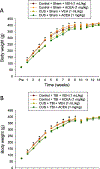Chronic unpredictable stress during adolescence protects against adult traumatic brain injury-induced affective and cognitive deficits
- PMID: 34090883
- PMCID: PMC8349874
- DOI: 10.1016/j.brainres.2021.147544
Chronic unpredictable stress during adolescence protects against adult traumatic brain injury-induced affective and cognitive deficits
Abstract
Pre-clinical early-life stress paradigms model early adverse events in humans. However, the long-term behavioral consequences of early-life adversities after traumatic brain injury (TBI) in adults have not been examined. In addition, endocannabinoids may protect against TBI neuropathology. Hence, the current study assessed the effects of adverse stress during adolescence on emotional and cognitive performance in rats sustaining a TBI as adults, and how cannabinoid receptor 1 (CB1) activation impacts the outcome. On postnatal days (PND) 30-60, adolescent male rats were exposed to four weeks of chronic unpredictable stress (CUS), followed by four weeks of no stress (PND 60-90), or no stress at any time (Control), and then anesthetized and provided a cortical impact of moderate severity (2.8 mm tissue deformation at 4 m/s) or sham injury. TBI and Sham rats (CUS and Control) were administered either arachidonyl-2'-chloroethylamide (ACEA; 1 mg/kg, i.p.), a CB1 receptor agonist, or vehicle (VEH; 1 mL/kg, i.p.) immediately after surgery and once daily for 7 days. Anxiety-like behavior was assessed in an open field test (OFT) and learning and memory in novel object recognition (NOR) and Morris water maze (MWM) tasks. No differences were revealed among the Sham groups in any behavioral assessment and thus the groups were pooled. In the ACEA and VEH-treated TBI groups, CUS increased exploration in the OFT, enhanced NOR focus, and decreased the time to reach the escape platform in the MWM, suggesting decreased anxiety and enhanced learning and memory relative to the Control group receiving VEH (p < 0.05). ACEA also enhanced NOR and MWM performance in the Control + TBI group (p < 0.05). These data suggest that 4 weeks of CUS provided during adolescence may provide protection against TBI acquired during adulthood and/or induce adaptive behavioral responses. Moreover, CB1 receptor agonism produces benefits after TBI independent of CUS protection.
Keywords: Cannabinoid receptor 1 (CB1); Chronic unpredictable stress (CUS); Controlled cortical impact (CCI); Early life stress (ELS); Endocannabinoids; Traumatic brain injury (TBI).
Copyright © 2021 Elsevier B.V. All rights reserved.
Figures




Similar articles
-
Galantamine and Environmental Enrichment Enhance Cognitive Recovery after Experimental Traumatic Brain Injury But Do Not Confer Additional Benefits When Combined.J Neurotrauma. 2017 Apr 15;34(8):1610-1622. doi: 10.1089/neu.2016.4790. Epub 2016 Dec 20. J Neurotrauma. 2017. PMID: 27806662 Free PMC article.
-
Attenuation of working memory and spatial acquisition deficits after a delayed and chronic bromocriptine treatment regimen in rats subjected to traumatic brain injury by controlled cortical impact.J Neurotrauma. 2002 Apr;19(4):415-25. doi: 10.1089/08977150252932370. J Neurotrauma. 2002. PMID: 11990348
-
Exploratory assessment of the effect of systemic administration of soluble glycoprotein 130 on cognitive performance and chemokine levels in a mouse model of experimental traumatic brain injury.J Neuroinflammation. 2024 Jun 5;21(1):149. doi: 10.1186/s12974-024-03129-0. J Neuroinflammation. 2024. PMID: 38840141 Free PMC article.
-
Applications of the Morris water maze in translational traumatic brain injury research.Neurosci Biobehav Rev. 2018 May;88:187-200. doi: 10.1016/j.neubiorev.2018.03.010. Epub 2018 Mar 13. Neurosci Biobehav Rev. 2018. PMID: 29545166 Review.
-
An Understated Comorbidity: The Impact of Homelessness on Traumatic Brain Injury.Neurotherapeutics. 2023 Oct;20(6):1446-1456. doi: 10.1007/s13311-023-01419-8. Epub 2023 Aug 28. Neurotherapeutics. 2023. PMID: 37639189 Free PMC article. Review.
Cited by
-
Neurobiological Links between Stress, Brain Injury, and Disease.Oxid Med Cell Longev. 2022 May 25;2022:8111022. doi: 10.1155/2022/8111022. eCollection 2022. Oxid Med Cell Longev. 2022. PMID: 35663199 Free PMC article. Review.
-
A bridge to recovery: Acute amantadine prior to environmental enrichment after brain trauma augments cognitive benefit.Exp Neurol. 2024 Mar;373:114648. doi: 10.1016/j.expneurol.2023.114648. Epub 2023 Dec 9. Exp Neurol. 2024. PMID: 38081352 Free PMC article.
-
High-Fat Diet Exacerbates Stress Responsivity in Juvenile Traumatic Brain Injury.J Neurotrauma. 2023 Jun;40(11-12):1216-1227. doi: 10.1089/neu.2022.0457. Epub 2023 Mar 10. J Neurotrauma. 2023. PMID: 36680746 Free PMC article.
-
Aquaporin 4 and the endocannabinoid system: a potential therapeutic target in brain injury.Exp Brain Res. 2024 Sep;242(9):2041-2058. doi: 10.1007/s00221-024-06896-7. Epub 2024 Jul 23. Exp Brain Res. 2024. PMID: 39043897 Free PMC article. Review.
-
Efficacy of a music-based intervention in a preclinical model of traumatic brain injury: An initial foray into a novel and non-pharmacological rehabilitative therapy.Exp Neurol. 2023 Nov;369:114544. doi: 10.1016/j.expneurol.2023.114544. Epub 2023 Sep 17. Exp Neurol. 2023. PMID: 37726048 Free PMC article.
References
-
- Alway Y, Gould KR, McKay A, Johnston L, Ponsford J. (2016). The evolution of post-traumatic stress disorder following moderate-to-severe traumatic brain injury. J Neurotrauma 33:825–831. - PubMed
-
- Andersen SL, Teicher MH. (2008). Stress, sensitive periods and maturational events in adolescent depression. Trends Neurosci. 31:183–191. - PubMed
-
- Bai F, Guo F, Jiang T, Wei H, Zhou H, Yin H, Zhong H, Xiong L, Wang Q. (2017). Arachidonyl-2-chloroethylamide alleviates cerebral ischemia injury through glycogen synthase kinase-3β-mediated mitochondrial biogenesis and functional improvement. Mol Neurobiol. 54:1240–1253. - PubMed
-
- Bharne AP, Borkar CD, Bodakuntla S, Lahiri M, Subhedar NK, Kokare DM. (2016). Pro-cognitive action of CART is mediated via ERK in the hippocampus. Hippocampus 26:1313–1327. - PubMed
Publication types
MeSH terms
Grants and funding
LinkOut - more resources
Full Text Sources

